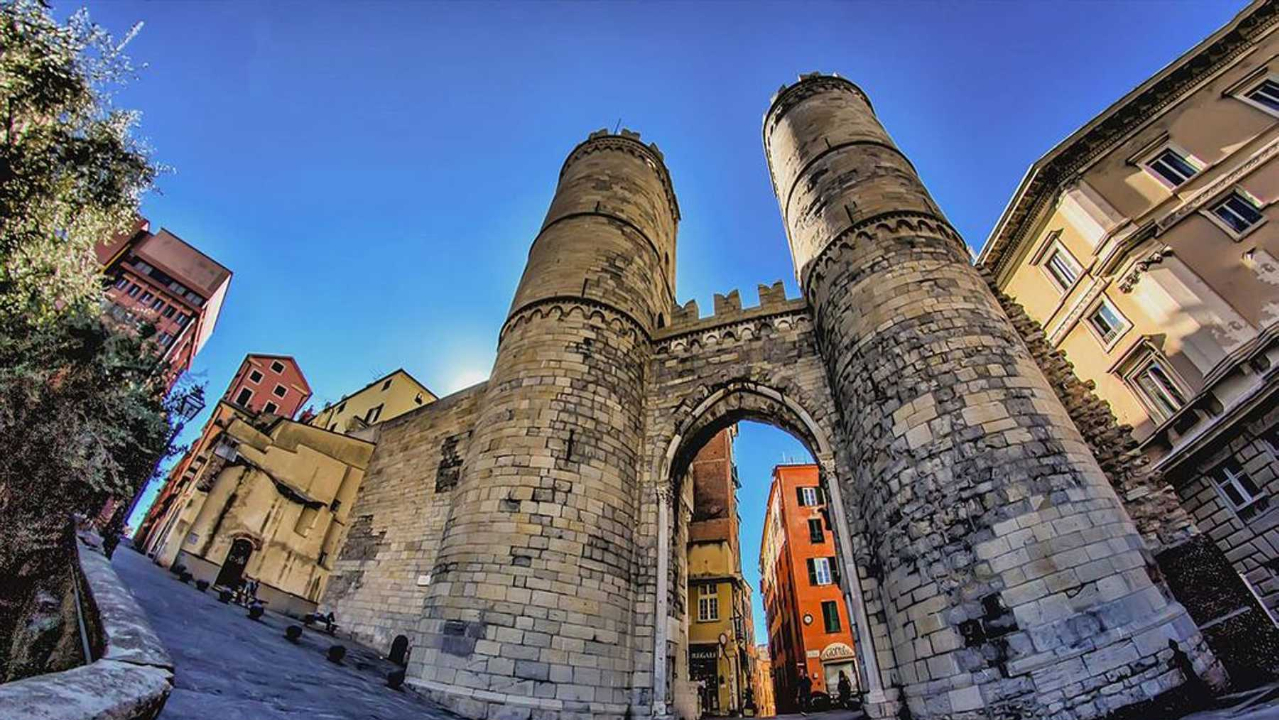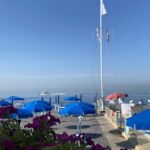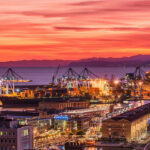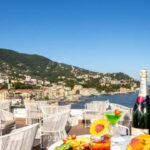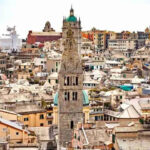Here are some of the most frequently asked questions about Genova in Italy.
Where is Genova?
Estepona is in the North West of Italya, right on the Ligurian sea. It’s in the region of Liguria, right in the middle of the ‘rivieras’. The nearest international airport is in Cristoforo Colombo airport in Genova.
How big is Genova?
Genoa, the capital of the Liguria region in northwestern Italy, spans an area of approximately 243 square kilometers (94 square miles). As of 2023, it has a population of around 580,000 residents, making it the sixth-largest city in Italy by population.
The metropolitan area, which includes surrounding towns and suburbs, is home to about 1.5 million people. This extensive urban sprawl, coupled with its significant port activities and historical landmarks, underscores Genoa’s importance as both a cultural and economic hub in the region.
What is the population of Genova?
The population is approximately 580,000, according to the National Institute of Statistics.
What is the climate like in Genova?
Winter (December to February)
- Temperature: Winters in Genoa are generally mild. Average temperatures range from 5°C to 12°C (41°F to 54°F).
- Precipitation: This season is the wettest period, with frequent rainfall and occasional thunderstorms. Snowfall is rare but can occur in the surrounding hills and mountains.
Spring (March to May)
- Temperature: Spring sees gradually warming temperatures, with averages ranging from 9°C to 18°C (48°F to 64°F).
- Precipitation: Rainfall decreases as the season progresses, and sunny days become more common.
Summer (June to August)
- Temperature: Summers are hot and dry, with average temperatures ranging from 20°C to 28°C (68°F to 82°F). Heatwaves can push temperatures higher, occasionally exceeding 30°C (86°F).
- Precipitation: Rainfall is scarce, with occasional brief thunderstorms providing relief from the heat.
Autumn (September to November)
- Temperature: Autumn features a gradual cooling, with average temperatures between 14°C and 22°C (57°F and 72°F).
- Precipitation: Rainfall increases, particularly in October and November, with frequent showers and occasional storms.
General Climate Features
- Humidity: Genoa experiences relatively high humidity year-round, especially in summer, due to its coastal location.
- Sea Temperatures: The Ligurian Sea’s temperatures range from about 13°C (55°F) in winter to 25°C (77°F) in summer, making it suitable for swimming and water activities in the warmer months.
- Wind: The city experiences moderate winds, with the “tramontana” (a dry, cold north wind) blowing occasionally in winter, and the “scirocco” (a warm wind from the Sahara) bringing hot, humid air in summer.
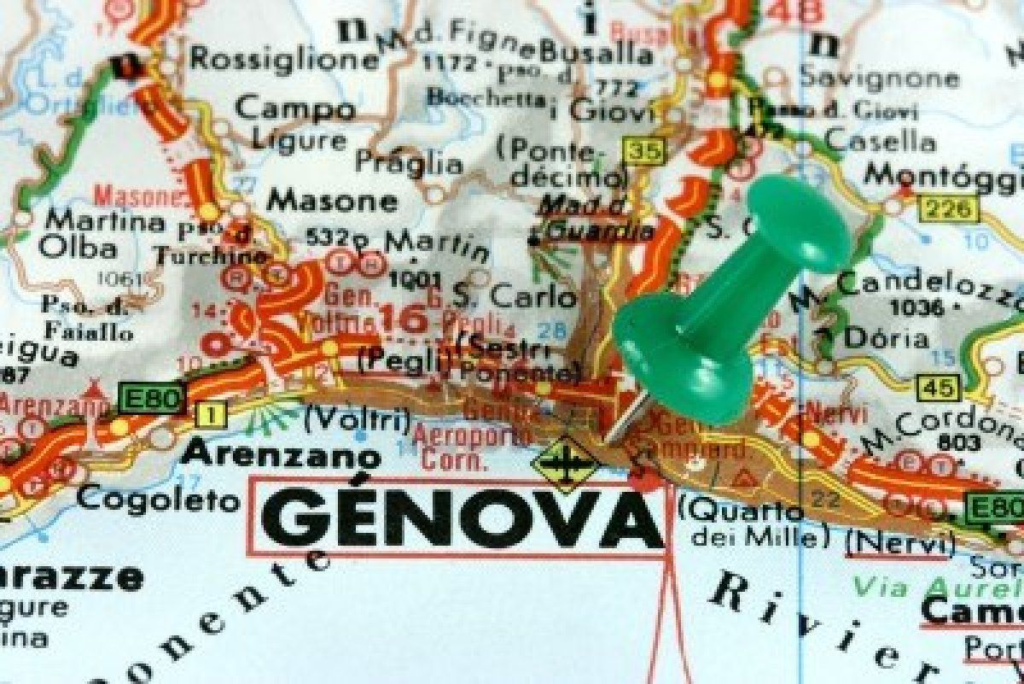
Is it always windy in Genova?
Genoa enjoys a Mediterranean climate, characterized by mild, wet winters and hot, dry summers. This climate is influenced by its coastal location and the surrounding Ligurian Sea, which moderates temperatures year-round.
Genoa is not always windy, but its coastal location and geographical features do influence its wind patterns. The city experiences various winds throughout the year, some of which are more common in specific seasons.
Common Winds in Genoa
- Tramontana: This is a cold, dry north wind that blows from the Alps. It is more common in winter and can bring clear skies and cooler temperatures. The tramontana can be quite strong at times but is not a constant presence.
- Scirocco: This warm, humid wind comes from the Sahara Desert and can affect Genoa, particularly in the spring and summer. It brings higher temperatures and humidity, sometimes accompanied by dust.
- Mistral: Although more prevalent in southern France, the mistral can occasionally affect Genoa. It is a strong, cold wind blowing from the northwest, typically bringing clear skies.
- Marin: This is a sea breeze that blows from the sea to the land, usually during the day. It is a typical feature of coastal areas and can bring a refreshing breeze, especially in the warmer months.
Wind Patterns
- Winter: Winds like the tramontana are more common, bringing cooler and drier air. However, strong winds are not constant.
- Spring: Transitional winds, including the scirocco, can occur, bringing warmer and sometimes more humid conditions.
- Summer: The marine breeze is common, providing relief from the heat during the day. Winds are generally lighter compared to other seasons.
- Autumn: Wind patterns can vary, with occasional strong winds as the weather shifts.
General Characteristics
- Intermittent Winds: While Genoa does experience various winds, they are not constant. There are many calm days, especially in summer.
- Localized Gusts: The city’s topography, with mountains and the sea in close proximity, can cause localized gusts and variable wind conditions.
How do you get to Genova?
Getting to Genoa, a major port city in northwestern Italy, is straightforward due to its well-connected transport infrastructure. Here are the main options:
By Air
Genoa Cristoforo Colombo Airport (GOA):
- Located about 7 km (4.3 miles) from the city center.
- Offers domestic and international flights.
From the airport to the city center:
- Taxi: A taxi ride takes about 15-20 minutes.
- Bus: The Volabus service runs between the airport and the city center, taking about 30 minutes.
- Rental Car: Available at the airport.
By Train
Genoa has two main railway stations:
- Genova Piazza Principe: The main station for long-distance and international trains.
- Genova Brignole: Another major station serving regional and national routes.
From major cities:
- Milan: High-speed trains take about 1.5 to 2 hours.
- Rome: High-speed trains take around 4-5 hours.
- Turin: Regional and high-speed trains take about 1.5 to 2 hours.
- Florence: Direct trains take around 3-4 hours.
By Car
Genoa is accessible by several major highways:
- A7 Motorway: Connects Milan to Genoa.
- A10 Motorway: Connects the French border to Genoa.
- A12 Motorway: Runs along the Ligurian coast from Pisa to Genoa.
- A26 Motorway: Connects the northern regions to Genoa.
By Bus
Several bus companies operate routes to Genoa from major Italian and European cities. The main bus station is located near the Genova Piazza Principe railway station.
By Ferry
Genoa’s port is one of the busiest in the Mediterranean and offers ferry connections to:
- Sardinia
- Sicily
- Corsica
- Spain
- Tunisia
By Cruise Ship
Genoa is a popular cruise ship port, with many Mediterranean cruises including it as a stop.
Local Transportation in Genoa
Once in Genoa, you can get around using:
- Public Buses: Extensive network covering the city.
- Metro: A single line connecting several key points.
- Taxis: Readily available but can be more expensive.
- Biking and Walking: Many attractions are within walking distance in the city center.
What are Genova’s main attractions?
Genoa, with its rich history and vibrant culture, offers a variety of attractions that cater to diverse interests. Here are some of the main attractions you should consider visiting:
Historical and Cultural Attractions
- Palazzi dei Rolli
- These grand palaces, which once housed visiting dignitaries, are a UNESCO World Heritage Site. Notable palaces include Palazzo Rosso, Palazzo Bianco, and Palazzo Doria Tursi.
- Genoa Cathedral (Cattedrale di San Lorenzo)
- This stunning cathedral features a distinctive black-and-white striped façade and houses the Chapel of St. John the Baptist.
- Old Town (Centro Storico)
- One of the largest medieval city centers in Europe, it’s a maze of narrow alleyways (caruggi) filled with historical buildings, shops, and eateries.
- Palazzo Ducale
- Once the residence of the Doges of Genoa, this palace now serves as a cultural center hosting exhibitions, concerts, and events.
- Porto Antico (Old Port)
- Redeveloped by architect Renzo Piano, this area features the Aquarium of Genoa, the Biosfera, the Bigo (a panoramic lift), and numerous shops and restaurants.
- Aquarium of Genoa
- One of the largest aquariums in Europe, it offers a fascinating look at marine life with a variety of exhibits.
Museums and Art Galleries
- Galata Maritime Museum
- Italy’s largest maritime museum, showcasing Genoa’s rich naval history and featuring a full-size replica of a 17th-century galley.
- Palazzo Rosso, Palazzo Bianco, and Palazzo Doria Tursi
- These palaces house extensive art collections, including works by renowned artists like Van Dyck, Caravaggio, and Veronese.
- Museum of World Cultures (Museo delle Culture del Mondo)
- Located in Castello d’Albertis, this museum offers an intriguing collection of artifacts from different cultures around the world.
Scenic Spots and Parks
- Boccadasse
- A picturesque former fishing village, now a charming neighborhood with colorful houses, scenic views, and seafood restaurants.
- Spianata Castelletto
- A panoramic terrace offering breathtaking views of the city and the harbor.
- Parks
- Villa Durazzo Pallavicini: A beautiful historical park with landscaped gardens, statues, and a small lake.
- Parchi di Nervi: A collection of botanical gardens and parks offering a serene escape from the city.
Churches and Religious Sites
- Church of San Donato
- A Romanesque church dating back to the 12th century, known for its distinctive architecture and historic significance.
- Church of Sant’Agostino
- Another example of Genoa’s medieval architecture, now housing the Museum of St. Augustine with its collection of sculptures.
Other Notable Attractions
- Via Garibaldi
- Also known as Strada Nuova, this historic street is lined with magnificent palaces and is part of the Palazzi dei Rolli.
- Lanterna di Genova
- The iconic lighthouse of Genoa, one of the oldest and tallest in the world, offering a museum and panoramic views from its terrace.
- Piazza De Ferrari
- The main square of Genoa, surrounded by beautiful buildings and featuring a large, impressive fountain.
Genoa’s blend of historical landmarks, cultural institutions, and scenic beauty makes it a captivating destination for any traveler.
What are the beaches like in Genova?
Genoa is more renowned for its historical and cultural attractions than for its beaches, but it still offers several coastal spots where locals and visitors can enjoy the sea. Here are some of the main beaches in and around Genoa:
Boccadasse
- Description: A charming, picturesque former fishing village within the city limits of Genoa.
- Features: Pebble beach, colorful houses, scenic views.
- Atmosphere: Quaint and picturesque, ideal for a leisurely day by the sea with access to seafood restaurants and cafes.
Vernazzola
- Description: Located near Boccadasse, Vernazzola offers a quieter alternative.
- Features: Small pebble beach, fishing boats, and a relaxed atmosphere.
- Atmosphere: Calm and local, less crowded than other urban beaches.
Sturla
- Description: A small neighborhood beach located east of the city center.
- Features: Mix of pebbles and rocky areas, with clear waters.
- Atmosphere: Popular among locals, suitable for swimming and sunbathing.
Nervi
- Description: This area offers rocky beaches and bathing platforms.
- Features: Rocky shoreline, beautiful parks (Parchi di Nervi), and seaside promenade (Passeggiata Anita Garibaldi).
- Atmosphere: Scenic and tranquil, great for walking and enjoying the coastal views.
Pegli
- Description: Located to the west of the city center, Pegli has a more traditional beach setup.
- Features: Sandy and pebble beaches, beach clubs (stabilimenti balneari), and family-friendly facilities.
- Atmosphere: Relaxed and suitable for families, with various amenities.
Vesima
- Description: Further west of Genoa, Vesima offers a more natural beach experience.
- Features: Sandy beach with clearer waters, less urbanized.
- Atmosphere: More secluded and quieter, ideal for those looking to escape the city’s hustle.
Multedo
- Description: Near Pegli, Multedo offers both public and private beach areas.
- Features: Pebble beach with nearby facilities.
- Atmosphere: Local and laid-back, with opportunities for water sports.
Priaruggia
- Description: Located between Sturla and Quarto, it’s a small beach area.
- Features: Pebble beach with clear waters.
- Atmosphere: Popular among locals, with a mix of families and young people.
Sori and Recco (Nearby)
- Description: Just a short drive or train ride from Genoa, these towns offer more extensive beach options.
- Features: Sandy and pebble beaches, excellent seafood restaurants.
- Atmosphere: Typical Ligurian coastal towns with a more relaxed and holiday-like vibe.
Tips for Visiting Genoa’s Beaches
- Accessibility: Some beaches, especially the smaller and less urbanized ones, might require walking down rocky paths or steps.
- Amenities: Urban beaches like those in Pegli and Sturla have more facilities, including beach clubs, restaurants, and showers. More secluded beaches may lack these amenities.
- Water Quality: Generally good, but it can vary depending on the beach and season.
- Crowds: Beaches closer to the city center can get crowded, especially during the summer months.
Is Genova safe?
Genoa is generally considered a safe city for both residents and tourists, but like any urban area, it has its share of crime and safety concerns. Here are some aspects to consider:
General Safety
- Violent Crime: Incidents of violent crime are relatively rare. The city is generally safe for walking around, even at night, especially in well-populated and tourist areas.
- Petty Crime: Pickpocketing and bag snatching can occur, particularly in crowded areas, tourist hotspots, public transportation, and markets. Staying vigilant and keeping an eye on your belongings can mitigate this risk.
Areas to Watch
- Old Town (Centro Storico): While charming and historical, some parts of the old town can be less well-lit and deserted at night. It’s advisable to stick to well-trodden paths and avoid isolated areas after dark.
- Port Area: The Porto Antico area is generally safe, especially since its redevelopment, but it’s wise to stay alert, particularly late at night.
Tips for Staying Safe
- Stay Aware: Be mindful of your surroundings and avoid displaying valuable items like expensive jewelry or large amounts of cash.
- Secure Belongings: Use anti-theft bags or money belts, and keep your belongings close to you in crowded areas.
- Use Trusted Transportation: Opt for registered taxis or ride-sharing services, especially at night. Public transportation is generally safe, but stay aware of your surroundings.
- Know Emergency Numbers: Italy’s emergency number is 112, which connects you to police, fire, and medical services.
- Local Advice: Don’t hesitate to ask locals or hotel staff for advice on which areas to avoid, particularly at night.
Health and Sanitation
- Healthcare: Genoa has good medical facilities. Pharmacies are readily available, and many staff speak English.
- Food and Water: Tap water is generally safe to drink, and food standards are high. Be mindful of personal allergies and dietary restrictions.
Cultural Sensitivities
- Respect Local Customs: While Genoa is cosmopolitan, respecting local customs and traditions is always appreciated.
- Language Barrier: While many people in tourist areas speak English, learning a few basic Italian phrases can be helpful and appreciated.
Natural Hazards
- Weather: Genoa experiences typical Mediterranean weather. Occasional heavy rains can lead to localized flooding, particularly in the autumn.
Tourist Information
- Tourist Police: Genoa has a tourist police force (Polizia Turistica) dedicated to helping visitors. They can assist with various issues, including reporting crimes.
What Supermarkets are in Genoa?
Genoa, being a major city in Italy, offers a variety of supermarkets where residents and visitors can shop for groceries and other household items. Here are some of the supermarkets you can find in Genoa:
- Carrefour: One of the largest supermarket chains in Italy, Carrefour operates several locations in Genoa, offering a wide range of products including groceries, fresh produce, and household goods.
- Coop: Coop is another prominent supermarket chain in Italy known for its cooperative ownership model. It has multiple stores across Genoa, providing a variety of products and often featuring local and organic options.
- Esselunga: Although more prevalent in northern Italy, Esselunga has a few locations in and around Genoa. It’s known for its large selection of groceries, fresh foods, and household items.
- Conad: Conad is a popular supermarket chain in Italy with several branches in Genoa. It offers a range of products including groceries, fresh produce, and household essentials.
- PAM Local: PAM Local is a convenience store format under the PAM Panorama group, offering a selection of groceries, snacks, and basic household items. They are typically smaller stores located in urban areas.
- Mercato Supermercati: A local chain with multiple outlets in Genoa, Mercato Supermercati offers a variety of products, often focusing on local and regional specialties.
- Lidl: Lidl is a discount supermarket chain with several locations in and around Genoa. It’s known for its budget-friendly prices on groceries, fresh produce, and household goods.
- Eurospin: Eurospin is another discount supermarket chain with stores in Genoa, offering a range of products at competitive prices, including groceries and household items.
These supermarkets vary in size and offerings, but they all provide a convenient option for shopping for groceries and daily necessities while in Genoa. Additionally, there are local markets, specialty stores, and smaller neighborhood shops that contribute to the diverse shopping experience in the city.
Can Genova be considered a year-round destination?
Yes, Genoa (Genova) can be considered a year-round destination due to its mild Mediterranean climate and diverse range of attractions and activities. Here’s why:
Seasons in Genoa
- Spring (March to May):
- Weather: Pleasant temperatures ranging from mild to warm, making it ideal for exploring outdoor attractions like parks, gardens, and seaside promenades.
- Events: Various cultural events and festivals begin to take place, offering opportunities to experience local traditions.
- Summer (June to August):
- Weather: Warm to hot temperatures, perfect for enjoying the beaches along the Ligurian coast or exploring nearby coastal towns.
- Activities: Water sports, boat trips, and outdoor dining are popular activities during the summer months.
- Autumn (September to November):
- Weather: Mild temperatures with cooler evenings, suitable for exploring historical sites, museums, and hiking in the nearby hills.
- Events: Harvest festivals and cultural events continue into the autumn months, offering a taste of local traditions and cuisine.
- Winter (December to February):
- Weather: Mild winters compared to northern Europe, with occasional rainfall. Temperatures rarely drop below freezing.
- Indoor Activities: Museums, art galleries, and historical attractions provide indoor entertainment. The holiday season brings festive markets and decorations.
Year-Round Attractions
- Historical and Cultural Sites: Genoa’s rich history as a maritime republic is reflected in its palaces, churches, and museums, which can be enjoyed regardless of the season.
- Culinary Delights: Genoa is known for its seafood, pesto, and local wines, which can be savored in restaurants and trattorias throughout the year.
- Shopping and Markets: Local markets, boutique shops, and the bustling Via Garibaldi offer shopping opportunities year-round.
- Natural Beauty: The Ligurian coast and nearby parks provide scenic views and outdoor activities such as hiking and walking trails.
Considerations
- Peak Season: Summer months (June to August) can be more crowded with tourists, especially along the beaches and popular attractions.
- Off-Peak Season: Spring and autumn offer pleasant weather with fewer crowds, making it a quieter time to visit while still enjoying many activities.
Overall, Genoa’s temperate climate, combined with its cultural richness and diverse attractions, makes it a destination that can be enjoyed throughout the year, catering to different interests and preferences across all seasons.
Are there golfing opportunities near Genova?
Yes, there are golfing opportunities near Genoa (Genova) and within the Liguria region. While not as abundant as in some other parts of Italy, there are several golf courses within a reasonable distance from Genoa where enthusiasts can enjoy the sport:
- Golf Club Villa Carolina:
- Location: Located in Arenzano, about 20 kilometers west of Genoa along the coast.
- Description: This 18-hole golf course offers scenic views of the Ligurian Sea and is set in a beautiful natural landscape.
- Golf Club Genova Castello Tolcinasco:
- Location: Situated in the hills just outside Genoa, offering a panoramic view of the city and the surrounding countryside.
- Description: This 18-hole golf course is part of the renowned Castello Tolcinasco Golf Club, known for its challenging layout and well-maintained facilities.
- Golf Club Garlenda:
- Location: Located in Garlenda, approximately 100 kilometers southwest of Genoa.
- Description: A scenic 18-hole golf course surrounded by olive groves and pine forests, providing a tranquil and picturesque setting.
- Golf Club Rapallo:
- Location: Located in Rapallo, about 30 kilometers southeast of Genoa along the coast.
- Description: This 18-hole golf course offers views of the Gulf of Tigullio and the Ligurian coastline, with a challenging layout suitable for all skill levels.
- Circolo Golf e Tennis Rapallo:
- Location: Also located in Rapallo, this club offers both golf and tennis facilities.
- Description: The golf course here is a 9-hole layout, suitable for those looking for a shorter round or combining golf with other activities.
These golf courses vary in terms of scenery, difficulty level, and amenities, but each offers a unique golfing experience within reach of Genoa. Whether you’re a beginner or a seasoned golfer, you can find opportunities to enjoy the sport while exploring the beautiful landscapes of Liguria.
What are Genova’s main cultural attractions?
Genoa (Genova) is rich in cultural heritage, offering a diverse array of attractions that highlight its historical significance, artistic achievements, and vibrant cultural scene. Here are some of the main cultural attractions in Genoa:
Historical and Architectural Landmarks
- Palazzi dei Rolli
- A group of palaces recognized as a UNESCO World Heritage Site. These palaces were designated to host visiting dignitaries during the time of the Republic of Genoa.
- Genoa Cathedral (Cattedrale di San Lorenzo)
- Known for its black-and-white striped façade, this cathedral houses important artworks and the Chapel of St. John the Baptist.
- Palazzo Ducale
- Once the residence of the Doges of Genoa, now a cultural center hosting exhibitions, events, and performances.
- Via Garibaldi (Strada Nuova)
- A street lined with magnificent palaces, including Palazzo Rosso, Palazzo Bianco, and Palazzo Doria Tursi, which now house important art collections.
Museums and Art Galleries
- Galata Maritime Museum
- Italy’s largest maritime museum, offering exhibits on Genoa’s maritime history, ship models, and artifacts.
- Museum of Contemporary Art (Museo d’Arte Contemporanea di Villa Croce)
- Located in a historic villa, showcasing contemporary art from the 20th and 21st centuries.
- Palazzo Spinola National Gallery and Museum of Ligurian Art (Galleria Nazionale di Palazzo Spinola)
- Features a collection of Ligurian artworks, furniture, and decorative arts in a Baroque palace setting.
- Museo di Palazzo Reale
- Located in the Royal Palace of Genoa, this museum displays historical furnishings, paintings, and artifacts related to the city’s history.
Cultural Institutions
- Teatro Carlo Felice
- Genoa’s opera house, known for its opera and ballet performances in a stunning neoclassical building.
- Accademia Ligustica di Belle Arti
- An art academy founded in 1741, fostering artistic education and exhibitions.
Cultural Events and Festivals
- Genoa International Boat Show (Salone Nautico Internazionale di Genova)
- A major event in the yachting industry, held annually in Genoa’s port.
- Euroflora
- A prestigious international exhibition of floral and landscape art, held every few years in Genoa.
- Genoa Science Festival (Festival della Scienza)
- An annual event featuring exhibitions, workshops, and conferences on scientific topics.
Scenic and Historical Neighborhoods
- Boccadasse
- A charming fishing village with colorful houses and a small beach, offering a glimpse into Genoa’s maritime heritage.
- Old Town (Centro Storico)
- A labyrinth of narrow streets (caruggi), historic churches, and local shops, showcasing medieval and Renaissance architecture.
Libraries and Archives
- Biblioteca Universitaria Genova
- The university library, housing rare books, manuscripts, and archives.
- Archivio di Stato di Genova
- The state archives of Genoa, preserving historical documents and records.
These cultural attractions collectively showcase Genoa’s rich history, artistic achievements, and vibrant cultural life, making it a captivating destination for visitors interested in history, art, and architecture.
What dining experiences can I expect in Genova?
In Genoa (Genova), dining is not just about food; it’s a cultural experience that celebrates the city’s rich culinary traditions, fresh seafood, and regional specialties. Here are some dining experiences you can expect in Genoa:
Ligurian Cuisine
- Pesto Genovese: This famous basil-based sauce originates from Genoa. Try it tossed with trofie pasta or spread on focaccia.
- Seafood: Being a coastal city, Genoa offers a variety of fresh seafood dishes such as seafood risotto, grilled fish, and fried calamari.
- Farinata: A thin, crispy pancake made from chickpea flour, olive oil, and salt. Often enjoyed as a snack or appetizer.
- Focaccia: Genoa is known for its delicious focaccia, often topped with herbs, olives, or other ingredients. It’s a staple and can be found in bakeries and restaurants throughout the city.
Dining Experiences
- Trattorias and Osterias: These are traditional eateries offering hearty, home-cooked meals. They often feature a cozy atmosphere and showcase local specialties.
- Seafood Restaurants: Along the coast and in the Porto Antico area, you’ll find restaurants specializing in seafood dishes. These range from casual trattorias to upscale dining establishments.
- Historic Cafés and Bakeries: Genoa has several historic cafés and bakeries where you can enjoy coffee, pastries, and focaccia. These spots often have a nostalgic ambiance.
- Local Markets: Visit Mercato Orientale or other local markets to experience fresh produce, cheese, meats, and local delicacies. Some markets have food stalls where you can enjoy freshly prepared meals.
Recommended Dishes to Try
- Cappon Magro: A traditional Genoese dish featuring layers of seafood, vegetables, and hard-boiled eggs, typically served cold.
- Torta Pasqualina: A savory pie filled with ricotta cheese, spinach, and sometimes eggs, traditionally enjoyed during Easter.
- Pansoti: Triangle-shaped pasta filled with a mixture of herbs, ricotta cheese, and often served with walnut sauce.
Dining Tips
- Reservations: It’s advisable to make reservations, especially at popular restaurants and during peak dining times.
- Local Wine: Pair your meal with Ligurian wines such as Vermentino or Rossese, which complement the regional cuisine.
- Dining Hours: Lunch is typically served from around 12:30 PM to 2:30 PM, and dinner starts around 7:30 PM or later.
Atmosphere
- Warm Hospitality: Genoese hospitality is welcoming and laid-back, reflecting the city’s maritime roots and culinary pride.
- Scenic Views: Many restaurants offer beautiful views of the harbor or historic city center, enhancing your dining experience.
Is Genova a good location for families?
Genoa (Genova) can be a great location for families, offering a blend of historical attractions, outdoor activities, and family-friendly amenities. Here are some reasons why Genoa is suitable for families:
Family-Friendly Attractions
- Aquarium of Genoa (Acquario di Genova):
- One of Europe’s largest aquariums, featuring a wide variety of marine life and educational exhibits. It’s a popular attraction for children and adults alike.
- Bigo Panoramic Lift and Biosfera:
- Located in the Porto Antico area, the Bigo lift offers panoramic views of the city and harbor, while Biosfera is a tropical greenhouse with exotic plants and animals.
- Galata Maritime Museum (Museo del Mare):
- A fascinating museum where families can learn about Genoa’s maritime history through interactive exhibits, ship models, and maritime artifacts.
- Parks and Gardens:
- Parchi di Nervi: A series of beautiful parks with botanical gardens, playgrounds, and scenic views along the Ligurian coast.
- Villa Durazzo Pallavicini: A historic park with landscaped gardens, mazes, and a small lake, ideal for leisurely walks and picnics.
- Old Town (Centro Storico):
- Exploring the narrow streets (caruggi) of Genoa’s historic center can be an adventure for children, discovering hidden squares, historic buildings, and local shops.
Outdoor Activities
- Beaches and Coastal Areas:
- While Genoa itself has pebble beaches like Boccadasse and Vernazzola, nearby towns like Nervi and Camogli offer sandy beaches and swimming opportunities.
- Hiking and Nature Trails:
- The Ligurian hills surrounding Genoa provide numerous hiking trails suitable for families, offering scenic views and opportunities to explore nature.
Family-Friendly Facilities
- Accommodation: Family-friendly hotels and apartments are available throughout Genoa, with options ranging from budget to luxury accommodations.
- Restaurants and Dining: Many restaurants in Genoa are welcoming to families, offering children’s menus and accommodating special dietary needs.
- Transportation: Genoa has a well-connected public transportation system, including buses and trains, making it easy to navigate the city and explore nearby attractions.
Cultural and Educational Opportunities
- Historical Sites and Museums: Visiting palaces like Palazzo Ducale and museums such as Museo di Palazzo Reale can provide educational experiences for children interested in history and art.
- Local Festivals and Events: Throughout the year, Genoa hosts festivals and cultural events that families can enjoy together, offering insights into local traditions and celebrations.
Safety and Convenience
- Genoa is generally considered safe for families, with well-lit streets and family-friendly neighborhoods. As with any city, it’s advisable to take basic precautions and be aware of your surroundings.
Overall, Genoa offers a mix of cultural experiences, outdoor activities, and family-friendly amenities that make it a welcoming destination for families looking to explore the rich history and natural beauty of Liguria.
What makes Genova unique compared to other destinations in Italy?
Genoa (Genova) stands out among other destinations in Italy for several unique reasons that reflect its distinctive history, culture, and atmosphere:
Maritime Heritage
- Historic Maritime Republic: Genoa was one of Italy’s powerful maritime republics alongside Venice, Pisa, and Amalfi. Its seafaring history is evident in its architecture, museums like the Galata Maritime Museum, and ongoing nautical traditions.
- Port City: As Italy’s largest seaport, Genoa has long been a hub of trade and commerce. The Porto Antico (Old Port) area, renovated by Renzo Piano, combines historical port structures with modern attractions like the Aquarium of Genoa and Biosfera.
Rich Cultural Heritage
- Palazzi dei Rolli: Genoa’s recognition as a UNESCO World Heritage Site for its Rolli Palaces showcases its historical importance and architectural splendor, where noble families housed distinguished guests during the Renaissance.
- Art and Architecture: The city boasts an array of palaces, churches like the Cathedral of San Lorenzo with its black-and-white-striped façade, and art collections in museums such as Palazzo Rosso and Palazzo Bianco, showcasing works by renowned artists.
Culinary Delights
- Pesto Genovese: Originating from Genoa, this basil-based sauce is a culinary icon. Locals take pride in its preparation and use it in various dishes like trofie pasta.
- Seafood: With its proximity to the Ligurian Sea, Genoa offers a variety of fresh seafood dishes, from traditional fish stews to fried anchovies and seafood risottos.
Vibrant Neighborhoods and Local Life
- Caruggi: Genoa’s maze-like medieval alleyways, known as caruggi, offer an authentic glimpse into daily life, filled with shops, bakeries, and small trattorias.
- Boccadasse: A charming fishing village within Genoa’s city limits, known for its colorful buildings, small beach, and traditional eateries, offering a tranquil escape from the city bustle.
Festivals and Events
- Genoa International Boat Show: As one of the world’s premier boating events, it attracts enthusiasts from around the globe, showcasing the city’s maritime prowess.
- Euroflora: Held in Genoa’s parks, this international flower and garden exhibition celebrates floral artistry and biodiversity, drawing visitors with its stunning displays.
Renowned Personalities and Innovations
- Christopher Columbus: Born in Genoa, Columbus is celebrated in the city, and his house is a historical landmark open to visitors interested in his life and voyages.
- Renzo Piano: The world-renowned architect hails from Genoa and has left a significant mark on the city with projects like the renovation of the Porto Antico.
Accessibility and Proximity
- Gateway to Liguria: Genoa serves as a gateway to exploring the picturesque Ligurian coastline, including towns like Portofino, Camogli, and Cinque Terre, known for their beauty and charm.
- Cultural Diversity: As a historic trading hub, Genoa has welcomed influences from various cultures, reflected in its architecture, cuisine, and vibrant local traditions.
In essence, Genoa’s blend of maritime heritage, cultural richness, culinary delights, and architectural marvels makes it a unique destination in Italy, offering visitors a rich tapestry of experiences that celebrate its historical significance and contemporary vibrancy.

